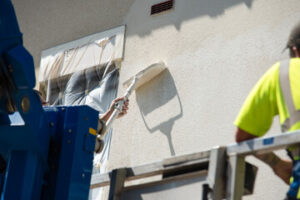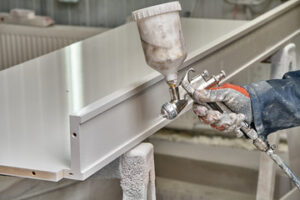Exterior painting is more than a cosmetic upgrade. It’s a protection plan, an energy solution, and an art. Every stroke serves a function beyond color. Today’s methods are more refined than ever.

Painters now assess homes using heat maps. This tool shows how walls retain sunlight over time. Areas that absorb more heat get tailored coatings. It reduces wear and improves thermal resistance. Contact Simplify Painting for professional help.
Surface chemistry is getting more attention lately. Paints are engineered to bond based on substrate type. Masonry and wood need different compounds. That ensures adhesion remains secure for years.
More homes are embracing reactive finishes. These coatings shift slightly with temperature changes. It prevents cracking during seasonal shifts. This creates flexible, long-lasting exteriors.
Exterior painting is also adapting to climate-aware designs. Homes in flood-prone areas now get water-shedding paint. The coat repels moisture without trapping humidity inside. This prevents rot and mold underneath.
A trend that’s gaining momentum is breathable barrier painting. These coatings allow walls to vent out moisture. Yet, they still block water from getting in. It’s a solution designed for humid climates.
Some painters are now working with biophilic concepts. The paint schemes mimic natural patterns or hues. These colors encourage calmness and visual rest. It links homes more closely with their environment.
Digital color heat tracking is emerging as a tool. Cameras detect how colors absorb and radiate heat. These findings influence final palette selection. It’s science behind shade choices, not just taste.
Dirt-resistant technologies are changing expectations. Paints infused with self-cleaning minerals now exist. These materials repel particles in rain and wind. Exteriors stay cleaner with little maintenance.
Repainting cycles are being extended. New formulas include micro-resins that resist chalking. This allows paint to keep its texture and color longer. It reduces the need for frequent refreshes.
Homeowners are requesting nighttime visibility features. Some paints now reflect low-level lighting. It improves safety and navigation at dusk. Plus, it subtly highlights architectural lines.
Color mood tracking is an emerging design consultation service. Apps can track emotional responses to exterior shades. This ensures homeowners feel connected to their paint choice. It removes second-guessing after application.
More homes are now painted with region-aware hues. The selection considers surrounding geography and light. Colors appear harmonious with soil, trees, and sky. This enhances curb appeal in a natural way.
Green wall transitions are also influencing exterior painting. Walls are painted to blend with climbing plants. It allows nature to grow while maintaining aesthetic control. These hybrids balance structure and wildness.
In some homes, exterior painting includes invisible climate signaling. Color-reactive molecules indicate temperature shifts. Though not obvious to the eye, they reflect change. It’s decorative yet informative.
Paint layering is now inspired by textile techniques. Base coats are textured to give dimension. Then smooth layers are added to enhance contrast. It adds visual richness without complicated patterns.
Some homes are using paint to tell stories. Artists embed motifs like waves, roots, or symbols. These represent family history or aspirations. It transforms paint into narrative surface design.
More painters are training in house psychology. They study how exterior appearance impacts perception. Lighter colors may lift mood or encourage social interaction. It’s a mindful approach to color.
Future-facing homes are adopting memory pigments. These paints return to original color after damage. It reduces the visibility of scratches or dents. They behave like a protective memory skin.
Insulation value is now part of paint conversations. Some coatings add measurable R-value to walls. This contributes to energy efficiency passively. It’s a small choice with a big impact.
Tactile finishes are becoming more common. Exteriors aren’t just about how they look but how they feel. Slightly textured paint adds sensory value. It also reduces glare under direct sun.
Community-based painting is rising in shared spaces. Coordinated schemes reflect unity in clustered homes. Painters collaborate across houses for cohesion. It builds visual and social harmony.
Some eco-homes are using reflective spectrum paints. These selectively reflect heat wavelengths. They keep interiors cool without darkening the exterior. Beauty and climate control meet in the finish.
Smart paint sensors are being embedded in select homes. These detect UV exposure or moisture levels. Homeowners receive alerts when it’s time to repaint. It prevents damage before it begins.
Worksite painting has gone quieter with new tools. Silent sprayers and whisper compressors reduce noise. This minimizes disruption to neighbors. It makes the process less invasive and more polite.
Color inheritance is a new way of keeping tradition. Families repaint in tones linked to their ancestors. It’s a way of preserving legacy through exterior walls. Paint becomes a living heritage symbol.
Seasonal painting packages are gaining interest. Painters return in different months for touch-ups. This counters fading due to season-specific exposure. It keeps homes fresh without full overhauls.
Time-release paint additives are being tested. These allow fresh pigments to slowly emerge. Over time, the house appears brighter. It’s a slow-blooming reveal designed by science.
UV-tuned finishes are another innovation. These paints interact with light to boost color clarity. They look more vivid under natural sunlight. This gives exteriors a glowing quality during the day.
Weather-mirroring paint is still conceptual but growing. The paint responds to outside conditions. When it rains, the hue deepens slightly. It offers a dynamic visual experience with each day.
Homes with rough exteriors are benefiting from absorption-level mapping. Painters now test how porous different wall sections are. Each spot gets treated based on absorption rate. This ensures consistency in the finish.
Virtual training modules for painters are leveling the field. Trainees use VR to learn brush control and layering. Mistakes happen in simulation, not on real homes. This raises the bar for entry-level work.
Exterior painting is also being integrated into soundproofing strategies. Special finishes reduce echo off hard surfaces. This makes homes quieter inside and out. It’s a subtle benefit that adds comfort.
Colors are now aligned with functional coding. Entryways, emergency paths, and shaded zones get unique tones. It aids navigation and safety without signage. Form and function blend seamlessly.
Flexible scaffold painting methods are replacing static systems. Painters use adjustable platforms for safer angles. It’s especially useful for irregular or sloped structures. Safety and access both improve.
Adaptive tinting is being tested in climate-change-prone regions. Paint changes shade slightly based on weather. It maintains visibility and beauty even in haze. The wall becomes a climate-aware canvas.
Some projects include sensory color blending. Homeowners are given color scent tests. Paints are chosen based on emotional and olfactory cues. This ensures a deeper connection to the home.
Exteriors are also being designed for drone visibility. Patterns are created for aerial appreciation. Drones can even apply paint in trial zones. It adds a futuristic dimension to curb appeal.
Digital twin simulations help plan large painting projects. Entire neighborhoods are rendered in 3D. Painters and planners preview the entire look. Mistakes are corrected before paint is even opened.
Maintenance-free coatings are being tested in dust-heavy areas. They include electrostatic layers that repel particles. Rainwater helps wash away grime. The house stays clean naturally.
Homes that shift uses seasonally have dual-tone exteriors. The color shifts subtly under different light angles. It gives the illusion of transformation. It’s functional design for flexible living.
Emergency signage is now being worked into exterior painting. Reflective icons guide rescue teams at night. These are subtly embedded in trim lines. Safety integrates with elegance.
Solar-sensitive exterior art is also on the rise. Designs only appear in direct sunlight. When shade hits, the design vanishes. It gives the home a magical, shifting personality.
Bio-reactive paints that nourish climbing plants are being tested. These coatings promote vine growth. Over time, walls bloom in foliage. It’s a collaboration between structure and biology.
Homeowners are also requesting chromatic storytelling. Paint schemes represent milestones like weddings or births. Each layer has a personal meaning. The wall becomes a celebration of life.
Exterior painting is being influenced by digital fasting. In a screen-heavy world, exteriors are designed for eye rest. Colors are muted, non-reflective, and gentle. The wall becomes a space to breathe.
Homeowners want more than protection. They want personality, memory, and science in every coat. Exterior painting is no longer an afterthought. It is architecture’s emotional and technological frontier.
